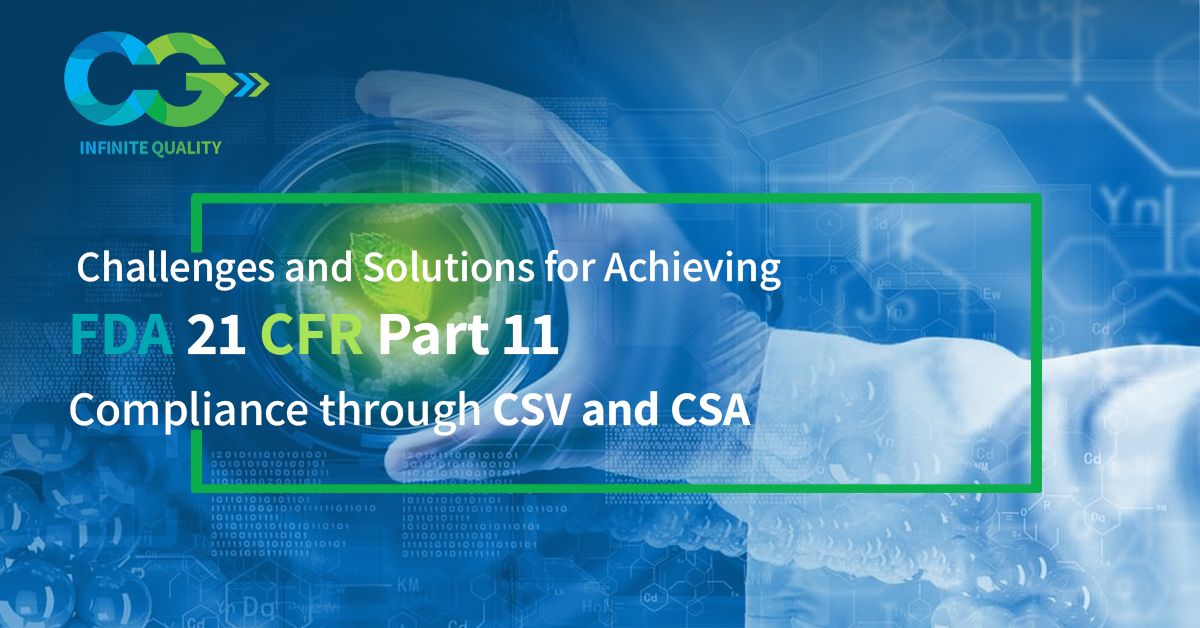Challenges and Solutions for Achieving FDA 21 CFR Part 11 Compliance through CSV and CSA

Article Context:
Navigating FDA 21 CFR Part 11 compliance requires a strategic approach to Computer System Validation (CSV)and Computer Software Assurance (CSA). Title 21 of the Code of Federal Regulations establishes requirements for guaranteeing the validity, consistency, and dependability of electronic records and signatures (ERES) that are used or submitted to the FDA. The FDA regulates pharmaceutical companies, medical device makers, biotech companies, and other businesses. The regulation is commonly known as Part 11.
Adopting robust validation processes, comprehensive documentation, and automated testing can address hurdles such as ensuring data integrity, electronic signatures, and audit trails. Implementing CSA principles like risk-based validation and continuous monitoring enhances compliance.
This blog explores how organizations can seamlessly integrate CSV and CSA methodologies to meet regulatory requirements, streamline processes, and uphold the highest standards in the life sciences industry.
What is FDA 21 CFR Part 11?
21 CFR Part 11 sets the standards for electronic records and electronic signatures in FDA-regulated industries. It's not just about going paperless; it's about ensuring data integrity, security, and traceability in a digital environment.
What are the challenges of implementing FDA 21 CFR Part 11?
Challenges:
- Understanding Part 11 Requirements: The first challenge organizations encounter is comprehending the intricacies of 21 CFR Part 11. It is a multifaceted regulation that requires a thorough understanding of electronic record-keeping, electronic signatures, and audit trails.
- Legacy Systems: Many organizations still rely on legacy systems that may not have been designed with Part 11 compliance in mind. Updating or replacing these systems can be costly and disruptive.
- Data Integrity and Security: Ensuring data integrity and security is paramount. Unauthorized access, data tampering, or system breaches can compromise compliance.
- Documenting and Validating Systems: Properly documenting and validating computer systems is a time-consuming and resource-intensive process. It involves creating and maintaining detailed records of system configurations, testing, and change controls.
- Employee Training: Employees must be trained to understand and follow Part 11 requirements, including the proper use of electronic signatures and the importance of maintaining data integrity.
- Resistance to Change within the Organization
- Traceability: Tracing the history of electronic records and electronic signatures, including who made changes and when, is vital for compliance.
- Integration of Technologies: Integrating various technologies (e.g., Electronic Document Management Systems, Electronic Lab Notebooks) for Part 11 compliance can be complex.
- Keeping up with Regulatory Updates
Solutions:
- Leadership Alignment: Ensure leadership at all levels understands the need for adoption, compliance, and their role in reinforcement and accountability.
- Communications: Proactively and continuously let the organization know what is happening and why. Awareness is the first step in learning and a crucial aspect of achieving FDA 21 CFR Part 11 compliance.
- System Assessment: Evaluate existing systems to identify gaps in compliance. Determine whether systems upgrades or replacements are necessary. For legacy systems, consider implementing controls and additional security measures.
- Documented Procedures: Develop and maintain detailed standard operating procedures (SOPs) for system operation, data handling, and electronic signature usage. Ensure that change control processes are documented and followed meticulously.
- Validation and Qualification: Implement a robust CSV process. Validate and qualify computer systems, ensuring they meet Part 11 requirements. Regularly re-validate systems after any significant changes.
- Access Controls: Implement strict access controls and user management to prevent unauthorized access to electronic records. Utilize user authentication mechanisms and role-based access controls.
- Audit Trails: Configure and maintain audit trails that record all changes and access to electronic records. Implement alerts and notifications for suspicious activities.
- Data Encryption: Use encryption techniques to secure data both in transit and at rest. Ensure that electronic signatures are protected from tampering.
- Comprehensive Training: Provide comprehensive training to employees involved in data management and system operation. Ensure they understand the specific requirements of 21 CFR Part 11 and their roles in maintaining compliance.
- Third-Party Auditing: Consider engaging third-party experts to conduct periodic audits of your systems and procedures to ensure ongoing compliance.
- Continuous Monitoring: Implement continuous monitoring and periodic risk assessments to identify and address compliance issues proactively.
- Organizational Change Management: Establish a full lifecycle, structured process that focuses on the people aspects of system/procedure implementation and compliance, including leadership alignment, communications/engagement, training, adoption, ongoing support, and measurement.
Conclusion
As technology continues to evolve, so do the challenges and opportunities in compliance. Today, we have sophisticated data management systems that can enhance compliance efforts. But how do we leverage these while remaining Part 11 compliance? Embracing robust CSV methodologies and integrating CSA principles not only addresses current hurdles but also paves the way for a future-proof, streamlined compliance framework.
At Compliance Group Inc, we understand the challenges faced by life sciences organizations that go beyond the physical equipment and delve into the heart of compliance challenges:
- Mindset Matters: Compliance starts with a mindset shift. It’s not just about ticking boxes and following procedures; it’s about cultivating a culture of quality and integrity.
- Documentation Discipline: Paperwork may not be the most exciting part of your job, but it’s vital. Ensure your documentation is accurate, up-to-date, and readily accessible.
- Training Triumphs: Compliance is a team effort, and training plays a crucial role.
- Tech Tools for Triumph: Leveraging technology can be a game-changer.
- Continuous Improvement: Compliance is not a one-time achievement, it’s a journey of continuous improvement.
To delve further into the mentioned insights and to benefit from a steadfast partnership, count on Compliance Group Inc. We are here to guide you not only towards compliance success but also in implementing effective Organizational Change Management (OCM) solutions for sustained excellence. Contact us at info@complianceg.com
FAQ's
What are the regulatory requirements for 21 CFR Part 11?
Federal regulations in the United States that outline FDA criteria for electronic records and signatures are found in 21 CFR Part 11. The requirements apply to businesses that deal with pharmaceuticals and medical devices.
What is 21 CFR Part 11 in CSV?
21 CFR Part 11 makes sure businesses follow ethical business practices. Part 11 enables a business to put in place computer systems that will significantly boost employee productivity, lower errors by identifying hazards, and raise total business productivity.
What is the difference between CSV and CSA Validation?
By applying critical thinking and taking risk into account, Computer Software Assurance (CSA) offers an alternative perspective on the conventional Computer System Validation (CSV) approach, with an emphasis on patient safety, product quality, and data integrity.
What are the features to assist with 21 CFR Part 11 compliance?
The Food and Drug Administration (FDA) has regulations called 21 CFR Part 11 that outline the specifications for electronic signatures and records. The goal of 21 CFR Part 11 is to guarantee the integrity, dependability, and authenticity of electronic signatures and documents.
What is the risk of not following 21CFR Part 11?
Organisations must adhere to 21 CFR Part 11 to improve quality control and preserve data integrity. Businesses should be aware that to comply with Part 11, they must have strong security measures in place, such as electronic signatures. This can enhance corporate procedures, safeguard intellectual property, lower the chance of legal action, and shield a company from liability.
What is the CSA risk-based approach?
To guarantee that software is appropriate for its intended use, Computer Software Assurance (CSA) employs a risk-based methodology. It is centered on locating, evaluating, and reducing computer system-related hazards.
What are the guidelines for CSV?
The following methods serve as the foundation for this Computer Systems Validation Guide:
- Method based on risk.
- Method based on the system’s life cycle.
- “v”-model approach for system testing and development.
- Method centered on the procedure that supports the system.
- Utilising the GAMP classification system.
What is Organizational Change Management?
Organizational Change Management, often abbreviated as OCM, is a structured approach to managing and facilitating change within an organization. It involves planning, implementing, and monitoring strategies and processes to help employees and stakeholders smoothly transition from the current state to a desired future state.
What is the difference between GMP and 21 CFR Part 11?
GMP (Good Manufacturing Practices) refers to a set of regulations and guidelines aimed at ensuring the quality, safety, and efficacy of pharmaceuticals, medical devices, and food products. GMP covers various aspects of manufacturing, including facilities, equipment, personnel, processes, and documentation.
21 CFR Part 11, on the other hand, specifically addresses the use of electronic records and electronic signatures in industries regulated by the FDA. It sets forth requirements for the electronic records and signatures to be trustworthy, reliable, and equivalent to paper records and handwritten signatures.
What are the core differences between 21 CFR Part 11 and EU Annex 11?
21 CFR Part 11 is a regulation issued by the Food and Drug Administration (FDA) in the United States, governing the use of electronic records and electronic signatures in FDA-regulated industries.
EU Annex 11 is a guideline issued by the European Medicines Agency (EMA), which outlines the principles and requirements for the use of computerized systems in the management of electronic data in the pharmaceutical industry within the European Union.
AUTHOR:
Lakshmi Chitrapu
Manager, Quality and Compliance
